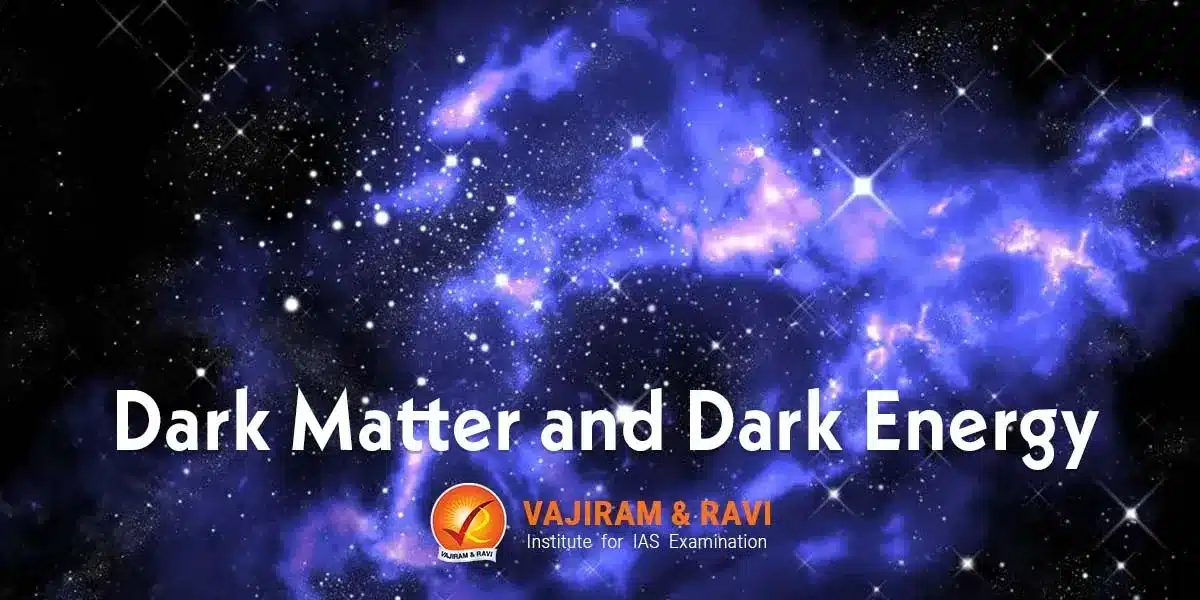Dark matter and dark energy are the mysterious components of the universe that contribute about 27% and 68% to its total content. Though they have not been directly observed, there is solid evidence for their existence from their gravitational effects. While dark matter governs cosmic structure formation based on its gravitational influence, dark energy exhibits a strong negative pressure driving the accelerated expansion of the universe.
In 1998, the Hubble Space Telescope discovered very distant supernovae and observed that the universe was expanding more slowly billions of years ago than it is today. This gave impetus to the study of dark matter and dark energy.
Dark Matter
It is a hypothetical form of matter that does not interact with light or other electromagnetic radiation. It is inferred to exist based on its gravitational effects on visible matter.
Background
- In 1933, Swiss astronomer Zwicky measured the velocities of galaxies within the Coma galaxy cluster and found that the mass required for binding the systems gravitationally was at least 400 times larger than expected from visible components.
- In the 1970s, galactic rotation curves were observed to remain flat at large distances rather than fall off as expected from Kepler’s laws.
This implied a huge extended halo of massive invisible matter dominating the universe.
Nature of Dark Matter
More than what dark matter is, physicists have found what dark matter is not.
- Dark: It does not interact with the electromagnetic waves. It is also not in the form of stars or planets.
- Non-baryonic: It is not in the form of dark clouds of normal matter, made up of baryons.
- Otherwise, the physicists would have been able to detect the baryonic clouds by their absorption of radiation passing through them.
- The cosmic abundances of normal protons, neutrons and other baryons are limited as confirmed by Cosmic Microwave Background measurements.
- Not an antimatter: It is not antimatter, otherwise we could observe the unique gamma rays produced when antimatter annihilates the matter.
- Not a large galaxy-sized black hole: Despite its huge gravitational effect, it is not a black hole, otherwise the scientists could have observed massive gravitational lensing in the universe.
- Not a MACHO: The possibility of being massive compact halo objects, or "MACHOs" is ruled out because dark matter is not baryonic at all.
- MACHOs are the celestial body that emits little or no radiation and moves through interstellar space. Black holes, neutron stars or brown dwarfs are considered MACHO.
- The baryonic matter when concentrated in a brown dwarf star or in dense, small chunks of heavy elements, is called MACHO.
- Can be made of WIMPS (Weakly Interacting Massive Particles):
- WIMPs are subatomic particles with mass, not made up of ordinary matter, and are weakly interacting as they can pass through ordinary matter without any observable effect.
- Neutrinos, neutralinos and axions are considered as WIMPS.
- Axions have been proposed to explain why the neutron does not have an electrical dipole moment.
- Neutralinos are members of a set of particles that have been proposed to understand supersymmetry.
- As about 23% of our universe is composed of dark matter, it favours the idea that dark matter may be made up of WIMPS.
- Neutrinos too may make up the dark matter, but they must not be a major component, due to their small mass.
- Axion and neutralino have enough properties to be dark matter, but yet to be detected.
Dark Energy

Scientists believe dark energy is accelerating the expansion of the universe, pushing it apart from gravity, unlike the force that pulls things together. So far, three possible theories have been predicted by physicists, to understand dark energy.
- Property of space: Dark energy is believed to be a property of space, discovered by Albert Einstein.
- Einstein's gravity theory proposed a cosmological constant and "empty space" that can possess its energy.
- Space has the unique property of gaining more space without the decline of its energy. This energy would have caused the universe to expand faster.
- But, no one understands why there is this cosmological constant and what is its value.
- Quantum theory of matter: The quantum theory of matter suggests that space is filled with temporary particles that continuously form and disappear.
- When physicists attempted to calculate the energy to fill the empty space, the answer was significantly wrong, with a 10^120 times larger number than expected, leaving the mystery unsolved.
- Dynamic form of energy: It was hypothesised that space could be filled with a new form of dynamical energy fluid or field, causing the universe's expansion opposite to matter and normal energy.
- Known as "quintessence," its nature, interactions, and existence remain mysteries, despite its potential explanation.
- Modified theory of gravity: Some physicists consider that Einstein's theory of gravity may not be correct and a new theory is needed to accommodate dark energy along with normal matter and energy.
- But what type of theory would it be, provided that it could correctly describe the currently described phenomena, is doubtful.
The decision between dark energy possibilities, such as space properties, dynamic fluids, or gravity theories, requiresmore and better data as well as understanding.
Dark Matter vs Dark Energy
Despite both being dominant cosmic ingredients, dark matter and dark energy have contrasting physical nature and cosmological impacts.

| Property | Dark Matter | Dark Energy |
| Composition | - Hypothesised Non-baryonic exotic particles | - Hypothetical form of energy |
| Abundance | - 27% of the total universal mass | - 68% of the total mass |
| Distribution | - Clumped halos around galaxies | - Smooth across space |
| Gravity Effect | - Attractive binding force | - Repulsive accelerating force |
| Signatures | - Gravitational effects on galaxies and clusters | - Cosmic acceleration measured from the supernova, CMB and large-scale structures |
| Impact | - Seed for galaxy and structure formation | - Drives accelerated expansion and influences the ultimate fate of the universe |
Way Forward
Unravelling the nature of dark matter and dark energy is among the biggest challenges in modern astrophysics and cosmology. Following efforts are needed to decode these peculiar phenomena.
- Study on WIMPS: WIMPS are being considered the best candidates for dark matter, more dedicated efforts are needed in this direction.
- Advanced observational technologies: Future space missions and ground-based observatories are expected to offer more precise data on dark matter and dark energy,
- Due to advancements in telescopes like the James Webb Space Telescope (JWST) and the upcoming Nancy Grace Roman Space Telescope.
- Particle Physics experiments: High-energy particle accelerators like the Large Hadron Collider (LHC) are expected to aid in the search for dark matter particles,
- Experiments focusing on direct detection, underground detectors, and novel techniques promising to reveal dark matter's nature.
Last updated on December, 2025
→ Check out the latest UPSC Syllabus 2026 here.
→ Join Vajiram & Ravi’s Interview Guidance Programme for expert help to crack your final UPSC stage.
→ UPSC Mains Result 2025 is now out.
→ UPSC Notification 2026 is scheduled to be released on January 14, 2026.
→ UPSC Calendar 2026 is released on 15th May, 2025.
→ The UPSC Vacancy 2025 were released 1129, out of which 979 were for UPSC CSE and remaining 150 are for UPSC IFoS.
→ UPSC Prelims 2026 will be conducted on 24th May, 2026 & UPSC Mains 2026 will be conducted on 21st August 2026.
→ The UPSC Selection Process is of 3 stages-Prelims, Mains and Interview.
→ UPSC Result 2024 is released with latest UPSC Marksheet 2024. Check Now!
→ UPSC Prelims Result 2025 is out now for the CSE held on 25 May 2025.
→ UPSC Toppers List 2024 is released now. Shakti Dubey is UPSC AIR 1 2024 Topper.
→ UPSC Prelims Question Paper 2025 and Unofficial Prelims Answer Key 2025 are available now.
→ UPSC Mains Question Paper 2025 is out for Essay, GS 1, 2, 3 & GS 4.
→ UPSC Mains Indian Language Question Paper 2025 is now out.
→ UPSC Mains Optional Question Paper 2025 is now out.
→ Also check Best IAS Coaching in Delhi

















